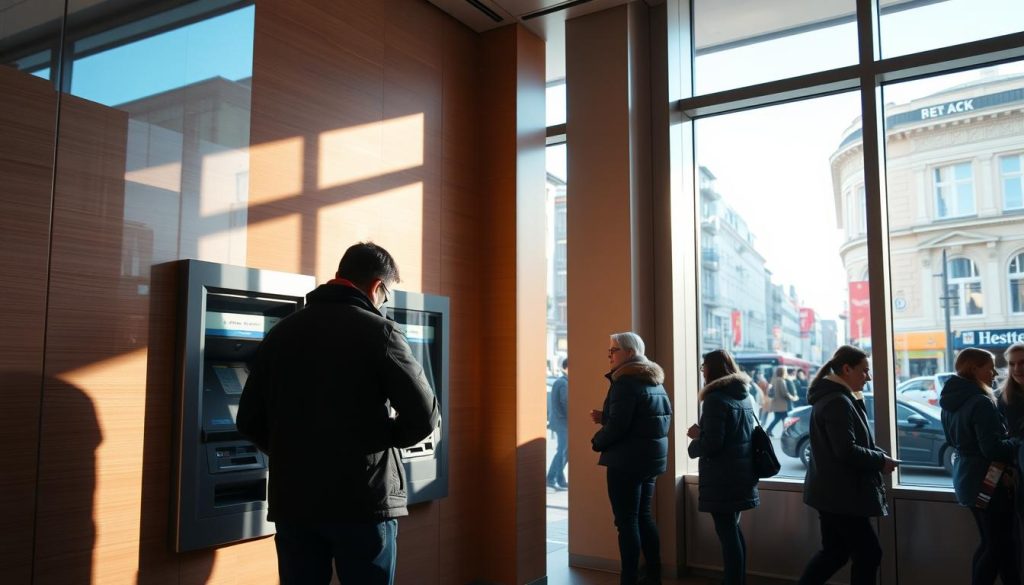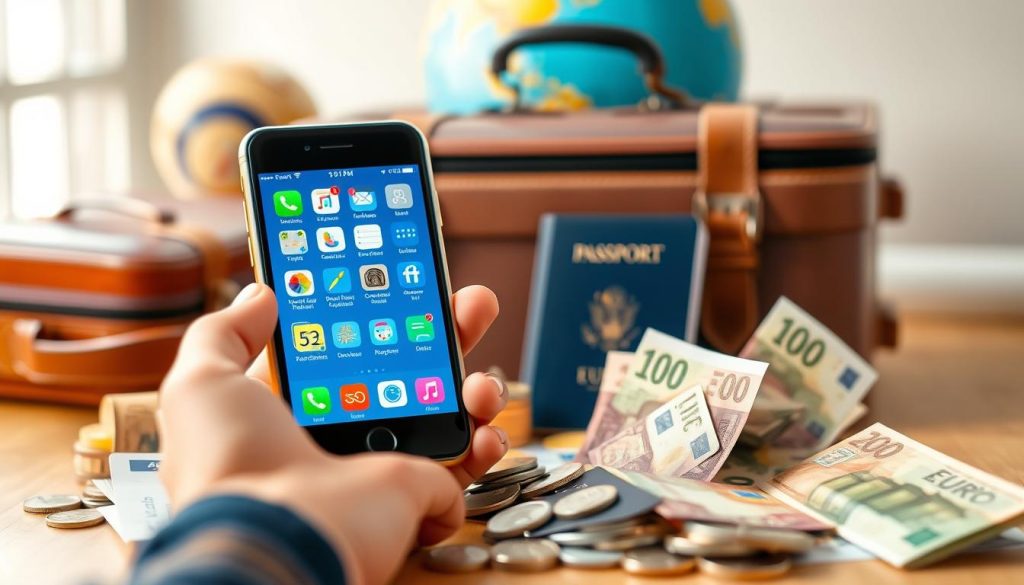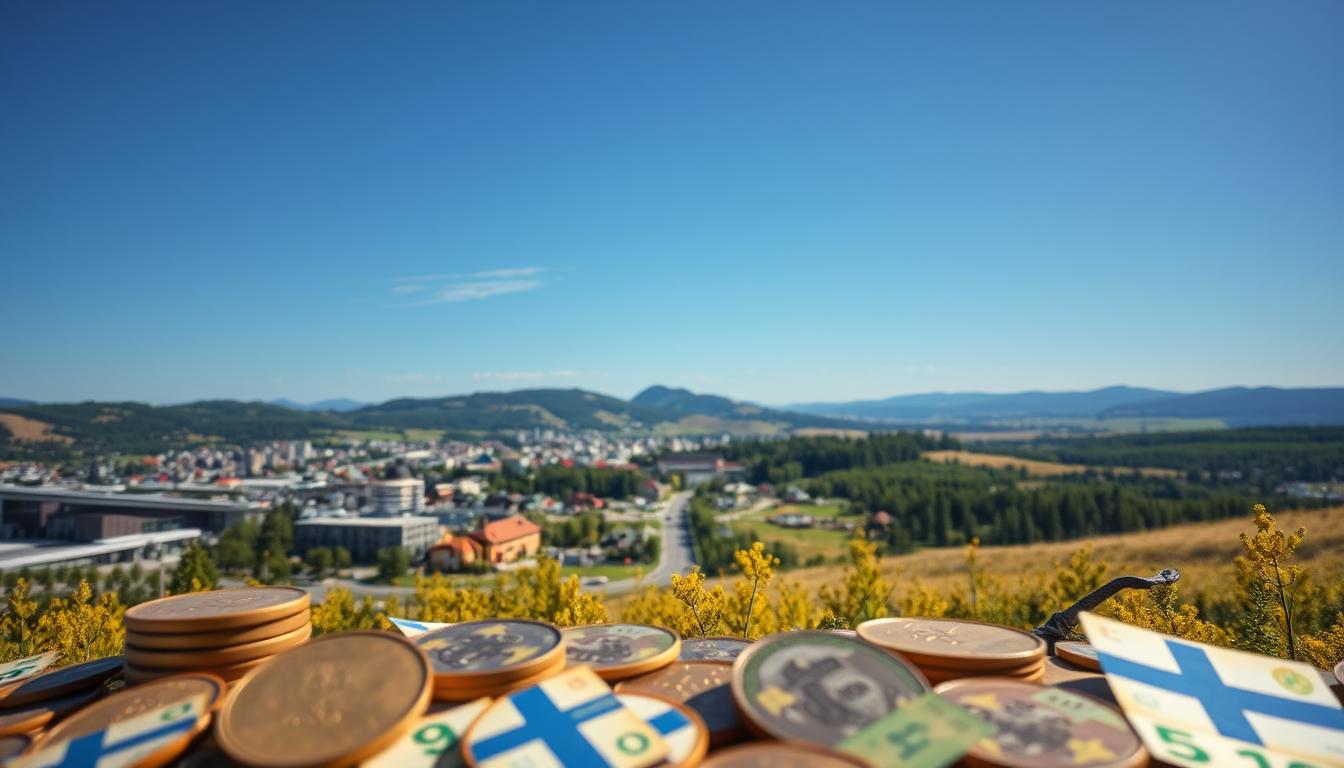Did you know that over 90% of transactions in Finland are card-based? This makes it one of the most cashless societies globally. If you’re planning a trip, understanding how to manage your money efficiently is essential.
Finland’s modern payment systems make it easy to use your card almost everywhere. The euro is the official currency, and knowing how to avoid hidden fees can save you a lot of hassle. Whether you’re exploring Helsinki or enjoying the Northern Lights, having the right payment methods ensures a smooth experience.
This guide will walk you through everything from using ATMs to understanding the exchange rate. You’ll also learn why carrying some cash can still be useful. Let’s dive in and make your trip as seamless as possible!
Introduction to Finland and Money Matters
Finland’s financial landscape blends modern technology with traditional practices, making it a fascinating destination for travelers. Whether you’re exploring Helsinki’s vibrant streets or venturing into the serene countryside, understanding how money works here can make your trip smoother.
In major cities, using a card is the norm. Public transportation, restaurants, and shops all accept card payments. However, in rural areas, you might find that some local markets or smaller establishments prefer cash. This mix of modern and traditional methods reflects the unique financial habits of the region.
Carrying a small amount of cash can be beneficial, especially when dealing with smaller vendors or in areas where card machines might not be available. Additionally, being aware of potential fees when using your card or withdrawing money can save you from unnecessary expenses.
Discovering Finland’s Unique Financial Landscape
Finland’s approach to money is a blend of innovation and tradition. While cards are widely accepted, there are still places where cash is king. This duality is part of what makes the country’s financial system so interesting.
Why Understanding Local Payment Methods Matters
Knowing how to navigate Finland’s payment systems ensures a hassle-free experience. Whether you’re in a bustling city or a quiet village, being prepared with the right payment methods can make all the difference.
| Payment Method | Where It’s Commonly Used | Tips |
|---|---|---|
| Card | Cities, public transport, restaurants | Check for foreign transaction fees |
| Cash | Rural areas, local markets | Carry small denominations |
| Mobile Wallets | Urban centers, tech-savvy establishments | Ensure compatibility with local systems |
By understanding these nuances, you can make the most of your travel experience in Finland. Whether you’re using a card, cash, or mobile payments, being informed will help you navigate the country’s financial landscape with ease.
Understanding the Euro: Finland’s Official Currency
Since 2002, the euro has been the official currency of Finland, simplifying transactions for locals and visitors alike. This single currency is used across 19 European countries, making it a convenient choice for travelers. Whether you’re shopping, dining, or exploring, knowing how the euro works ensures a seamless experience.

Euro Banknotes and Coins Explained
The euro comes in seven banknote denominations: €5, €10, €20, €50, €100, €200, and €500. Each note features distinct designs and colors, making them easy to identify. Coins are available in eight values: 1, 2, 5, 10, 20, and 50 cents, as well as €1 and €2. Finnish euro coins have unique national designs, such as the heraldic lion, which reflects the country’s heritage.
When handling currency, you’ll notice that prices are often labeled with the euro symbol (€) or written in cents. This consistency helps avoid confusion, especially for those new to the system. Carrying a mix of banknotes and coins can be practical for smaller purchases or in areas where card payments aren’t accepted.
A Brief History from Markka to Euro
Before the euro, Finland used the Finnish markka, which had been in circulation since 1860. The transition to the euro began in 1999, with the fixed exchange rate set at 5.94573 markka to 1 euro. By January 2002, physical euro banknotes and coins were introduced, replacing the markka entirely. This shift marked a significant step in Finland’s integration into the European Union and its economy.
The adoption of the eur streamlined international payments and improved access to global financial markets. Today, the euro is a symbol of unity and efficiency, making it an essential part of Finland’s financial landscape. Understanding its history and features will help you navigate the country’s currency system with confidence.
Finances on the Go: ATMs, Cards, and Digital Payments
Managing your finances while traveling has never been easier, thanks to modern payment methods. Whether you’re exploring bustling cities or serene countryside, understanding how to use ATMs, cards, and digital wallets ensures a smooth experience.
Using ATMs Effectively
ATMs are widely available across both urban and rural areas, making it convenient to access cash when needed. Independent operators like Otto and Nosto are common, and most machines accept multiple card types, including international ones. Always check with your bank about potential fees for withdrawals abroad to avoid surprises.
For larger transactions, consider making fewer, bigger withdrawals to minimize per-transaction fees. Be cautious of dynamic currency conversion (DCC) at ATMs, as it can lead to unfavorable exchange rates. Stick to local currency for the best deal.
Embracing Contactless and Mobile Wallet Options
Contactless payments are a game-changer, accounting for over 65% of transactions. Most places accept cards with contactless features, and mobile wallets like Apple Pay and Google Pay are becoming increasingly popular. These options are not only quick but also secure, reducing the need to carry physical cash.
Using a trusted app for managing your travel money can add an extra layer of convenience. Apps like Wise or Revolut allow you to track expenses and avoid hidden fees. Always ensure your device is secure and your apps are up to date for safe transactions.
By leveraging these modern payment methods, you can enjoy a hassle-free trip. Whether you’re using an ATM, swiping your card, or tapping your phone, staying informed ensures you’re always in control of your finances.
How to Get Cash and Currency in Finland
Getting cash while traveling doesn’t have to be complicated if you know the right methods. In Finland, accessing cash is straightforward, but choosing the best option can save you time and money. Whether you prefer ATMs or currency exchange offices, understanding the pros and cons of each method ensures you’re always prepared.

ATMs vs. Currency Exchange Offices
ATMs are widely available and often the most convenient way to get cash. They’re found in cities, rural areas, and even at airports. Most machines accept international cards, and withdrawals are processed in euros, which helps you avoid unfavorable exchange rates. However, be mindful of potential fees from both the ATM operator and your bank.
Currency exchange offices, on the other hand, are common in major cities and shopping centers. While they offer the convenience of instant cash, their rates are often less favorable than ATMs. Additionally, airport exchange counters tend to charge higher fees, so it’s best to avoid them unless absolutely necessary.
Tips for Avoiding High Withdrawal and Exchange Fees
To minimize costs, follow these practical tips:
- Use partner banks: Some banks have agreements with international partners, offering free or reduced withdrawal fees.
- Withdraw larger amounts: Fewer, bigger transactions can help reduce per-transaction fees.
- Decline dynamic currency conversion: Always choose to withdraw in euros to avoid unfavorable rates.
- Plan ahead: Avoid airport exchanges and withdraw cash as needed to avoid carrying excessive amounts.
By understanding these options and strategies, you can access cash efficiently and avoid unnecessary expenses. Whether you’re in a bustling city or a quiet village, being prepared ensures a smooth and stress-free experience.
Finland: Ultimate Travelers Guide to Currencies & Payments
Choosing the right payment method can make or break your travel experience. In Finland, both debit and credit cards are widely accepted, but understanding their differences is key to managing your money effectively.
Debit Cards: Direct Access to Your Funds
A debit card allows you to spend directly from your bank account, making it a practical choice for everyday expenses. It’s ideal for travelers who want to avoid accumulating debt. However, be mindful of potential fees for international transactions or ATM withdrawals.
Using a debit card in Finland is straightforward, as most shops and restaurants accept major networks like Visa and MasterCard. For larger purchases, ensure your daily withdrawal limit is sufficient to avoid multiple transaction fees.
Credit Cards: Flexibility and Rewards
Credit cards offer flexibility and often come with rewards like cashback or travel points. They’re great for larger expenses or emergencies, as they provide a buffer before you need to repay the balance. However, foreign transaction fees can add up, so check your card’s terms before using it abroad.
In Finland, credit cards are widely accepted, especially in urban areas. Some cards also offer travel insurance or purchase protection, adding an extra layer of security for your trip.
Strategies for Seamless Transactions
To ensure smooth transactions, choose a money card that minimizes fees. Look for options with no foreign transaction fees or ATM withdrawal charges. Apps like Wise or Revolut can help you track spending and avoid unnecessary costs.
Always monitor your account activity to spot any unauthorized charges. Notify your bank of your travel plans to prevent your card from being blocked. By staying informed and prepared, you can enjoy a hassle-free experience with your card in Finland.
Practical Spending Tips for Your Trip
Making the most of your travel budget requires smart spending strategies. Whether you’re exploring bustling cities or quiet villages, knowing when to use your card and when to carry cash can save you time and money. Let’s dive into some practical tips to help you manage your money efficiently.

Balancing Card Use and Carrying Cash
In urban areas, cards are the go-to payment method. Most shops, restaurants, and public transport systems accept contactless payments, making them quick and convenient. However, in rural areas or smaller markets, carrying some cash can be essential. Here’s a quick guide to help you decide:
| Payment Method | Best For |
|---|---|
| Card | Urban areas, restaurants, public transport |
| Cash | Rural markets, small vendors, emergencies |
For example, while dining in a city restaurant, using your card is ideal. But when buying souvenirs from a local artisan, cash might be the better option. This balance ensures you’re prepared for any situation.
How to Avoid Unnecessary Foreign Transaction Fees
Foreign transaction fees can quickly add up, but there are ways to minimize them. First, choose a card with no foreign transaction fees. Many travel-friendly cards offer this benefit. Second, always decline dynamic currency conversion (DCC) at ATMs or payment terminals. This ensures you’re charged in the local currency, avoiding unfavorable exchange rates.
“Using a travel-friendly card can save you up to 3% on every transaction, which adds up over time.”
Additionally, consider using apps like Wise or Revolut to track your spending and avoid hidden fees. These tools can also help you budget effectively, ensuring you stay on track during your trip.
By following these tips, you can enjoy a hassle-free experience while keeping your money safe and your spending under control. Whether you’re swiping your card or handing over cash, being prepared makes all the difference.
Safety and Security for Your Money in Finland
Keeping your money secure while traveling is essential for a stress-free experience. While the country is known for its low crime rate, it’s still important to take precautions to protect your money and personal information. By staying informed and vigilant, you can avoid common risks and enjoy your trip without worry.
Preventing Card Skimming and Fraud
Card skimming and fraud are rare but can happen, especially in busy areas. To protect your card, always use ATMs located inside banks or secure locations. Avoid standalone machines in poorly lit or isolated areas. Check for any unusual devices attached to the ATM before inserting your card.
When making transactions, shield your PIN with your hand to prevent prying eyes. If you notice any suspicious activity, report it immediately to your bank. Regularly monitor your account for unauthorized charges to catch potential issues early.
Staying Vigilant in Crowded Areas and On Public Transport
Crowded places like markets, train stations, and tourist attractions can be hotspots for petty theft. Keep your money and cards in a secure, hard-to-reach place, such as a money belt or an inside pocket. Avoid displaying large amounts of cash or valuable items in public.
On public transport, stay alert and keep your belongings close. Pickpockets often target distracted travelers, so remain aware of your surroundings. If you’re carrying a bag, keep it zipped and in front of you.
| Safety Tip | Why It’s Important |
|---|---|
| Use ATMs inside banks | Reduces the risk of card skimming |
| Monitor your transactions | Helps detect unauthorized activity early |
| Keep cash and cards secure | Prevents theft in crowded areas |
| Be cautious with contactless payments | Minimizes the risk of digital fraud |
By following these simple steps, you can safeguard your money and focus on enjoying your trip. While the country is generally safe, a little vigilance goes a long way in ensuring your financial security.
Utilizing Money Transfer Services and Financial Apps
Modern technology has revolutionized how we handle money while traveling. With the rise of financial apps and services, managing your travel money has never been easier. These tools not only simplify transactions but also help you avoid unnecessary fees.

Introducing the Wise Travel Money Card
The Wise Travel Money Card is a game-changer for travelers. It allows you to top up in local currency and offers mid-market exchange rates, ensuring transparency and savings. With fee-free transactions at ATMs, it’s a reliable choice for accessing cash abroad.
Using the Wise card, you can manage multiple currencies in one account. This flexibility makes it ideal for frequent travelers who want to avoid carrying multiple cards. Plus, its user-friendly app lets you track expenses and monitor exchange rates in real-time.
Helpful Currency Converter and ATM Fee Apps
Currency converter apps are essential for planning your expenses. They provide accurate exchange rate information, helping you budget effectively. Apps like XE and CurrencyFair are popular choices for their reliability and ease of use.
ATM fee apps, on the other hand, help you ’ll find nearby ATMs with low or no fees. This can save you significant money, especially in countries where withdrawal fees are high. Combining these tools with a money card like Wise ensures a seamless financial experience.
“With the right financial tools, managing your money abroad becomes effortless and cost-effective.”
Here’s how these tools can enhance your trip:
- Track expenses: Use apps to monitor spending and stay within budget.
- Avoid fees: Choose ATMs and cards with low or no transaction fees.
- Plan ahead: Use currency converters to estimate costs before making purchases.
By leveraging these digital innovations, you can focus on enjoying your trip without worrying about travel money. Whether you’re using a card, converting currencies, or finding the best atm, these tools make managing your finances safe and efficient.
Additional Money-Saving Strategies for Travelers
Saving money while traveling is easier than you think with the right strategies. Whether you’re exploring bustling cities or serene countryside, a few smart choices can help you stretch your budget further. Here are some lesser-known tips to reduce costs and make the most of your travel money.
Local Tips for Reducing Currency Exchange Costs
One of the biggest expenses travelers face is currency exchange fees. To avoid unnecessary costs, steer clear of airport exchange desks. Their rates are often less favorable, and they charge higher fees. Instead, use local banks or trusted forex offices in the city for better exchange rates.
Mobile apps can also be a lifesaver. Tools like XE or CurrencyFair let you compare rates in real-time, ensuring you get the best deal. Some apps even allow you to lock in a rate before making a transaction, saving you money in the long run.
Small changes in your spending habits can lead to significant savings. For example, using a card with no foreign transaction fees can save you up to 3% on every purchase. Additionally, withdrawing larger amounts of cash less frequently can reduce ATM fees.
| Strategy | Benefit |
|---|---|
| Avoid airport exchange desks | Lower fees and better rates |
| Use currency comparison apps | Find the best exchange rates |
| Choose fee-free cards | Save on foreign transaction fees |
| Withdraw larger cash amounts | Reduce ATM withdrawal fees |
Staying informed about local financial trends can also help you maximize your savings. For instance, knowing when the exchange rate is most favorable can make a big difference. By combining these strategies, you can keep more money in your pocket and enjoy your trip without financial stress.
Conclusion
Planning your finances for a trip doesn’t have to be stressful when you’re well-prepared. This guide has covered everything from understanding the euro to using digital payment tools, ensuring you’re ready for any situation. Balancing cash and card usage can save you from unnecessary fees, while smart spending keeps your money safe and your trip smooth.
Remember, being informed is the key to a stress-free experience. Whether you’re exploring bustling cities or quiet villages, these tips will help you navigate the financial landscape with ease. Keep this guide handy for future trips, and you’ll always feel confident managing your money abroad.
Now that you’re equipped with practical advice, it’s time to enjoy your trip with peace of mind. Safe travels, and make the most of your time exploring!
The above is subject to change.
Check back often to TRAVEL.COM for the latest travel tips and deals.
Here are some Tours & Sightseeing suggestions that might pique your interests!





